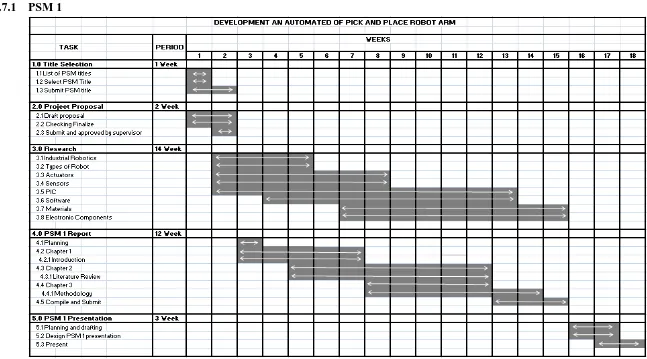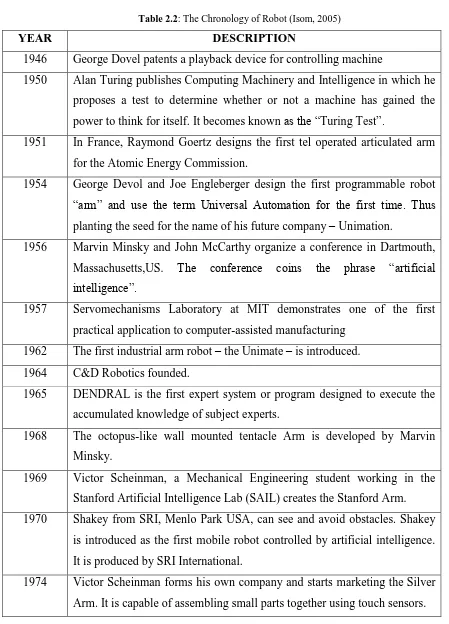UNIVERSITI TEKNIKAL MALAYSIA MELAKA
BORANG PENGESAHAN STATUS LAPORAN PSM
TAJUK:
‘Programming An Automated Pick And Place Robot’
SESI PENGAJIAN: 2009/20010 Semester 2
Saya AZRAI BIN MUHAMMAD
mengaku membenarkan laporan PSM ini disimpan di Perpustakaan Universiti Teknikal Malaysia Melaka (UTeM) dengan syarat-syarat kegunaan seperti berikut:
1. Laporan PSM / tesis adalah hak milik Universiti Teknikal Malaysia Melaka dan penulis.
2. Perpustakaan Universiti Teknikal Malaysia Melaka dibenarkan membuat salinan untuk tujuan pengajian sahaja dengan izin penulis.
3. Perpustakaan dibenarkan membuat salinan laporan PSM / tesis ini sebagai bahan pertukaran antara institusi pengajian tinggi.
kepentingan Malaysia yang termaktub di dalam AKTA RAHSIA RASMI 1972)
(Mengandungi maklumat TERHAD yang telah ditentukan oleh organisasi/badan di mana penyelidikan dijalankan)
DECLARATION
I hereby declared this report entitled “Programming of an Automated Pick and Place Robot” is the result of my own research except as cited in the references.
Signature : ………..
Author’s Name : ………...…Azrai Bin Muhammad…….……..
APPROVAL
This report is submitted to the Faculty of Manufacturing Engineering of UTeM as a partial fulfillment of the requirements for the degree of Bachelor of Manufacturing Engineering (Robotics and Automation) with Honours. The members of the supervisory committee are as follow:
……… Supervisor
( En. Lokman Bin Abdullah ) Faculty of Manufacturing Engineering
ABSTRACT
ABSTRAK
DEDICATION
ACKNOWLEDGEMENTS
Alhamdulliah, I would like to express my thankfulness to Allah S.W.T because has given me all the strength that I need in fulfilling and completing my Projek Sarjana Muda and selawat is upon to the Prophet Muhammad S.A.W. I would like to thank my supervisor Encik Lokman Bin Abdullah for his constructive guidance encouragement and patient in fulfilling our aspiration in completing this project and also to my entire lecturers and technicians for their advice and motivation to development this project. I am especially thanks to my friends for their generosity in sharing information regarding to programming an automated pick and place robot.
2.3.3 Motion Kinematics 14
2.3.4 Cycle Time 14
2.4 Pick and Place Robot Arm 15
2.5 Robot Programming 16
2.5.1 Automatics Programming System 18
2.6 Control System of Pick and Place Robot Operating System 19
2.7 Actuator 20
2.9 Peripheral Interface Control (PIC) 26
2.91 PIC16F877A 26
2.9.2 PIC16F877A features 28
2.10 Programming Software 29
2.10.1 Micro Compiler Software 30
2.10.2 MPLAB IDE 31
2.10.3 ISIS 7 Professional 32
METHODOLOGY 33
3.0 Introduction 33
3.1 Process Flow Chart 34
3.2 Implementation of Project 36
PROGRAMMING 38
4.0 Introduction 38
4.2 Planning for the Project 39 4.2.1 Process Flow Chart for Automated Pick and Place Robot 40
4.3 PIC Programming Software 41
4.3.1 MPLAB IDE Software 41
4.3.2 Process Flow to Start a New Project 42 4.3.3 Procedure to Create a New Project 43 4.3.4 Process Flow For Start a Programming 47
4.3.5 Procedure to Start a Programming 48
4.4 PICkit Software 52
4.4.1 Process Flow to Transfer Data to PIC 52 4.4.2 Procedure to Transfer Data to PIC 53
4.4.3 USB PIC Programmer 55
4.5 Programming Algorithm 56
RESULT AND DISCUSSION 58
5.0 Introduction 58
5.1 Result and Discussions 58
LIST OF TABLES
2.1 Robot Primitive Defined in Terms of Input and Output 8
2.2 The Chronology of Robot 9
2.3 PIC 16F877A Features 28
4.1 List of Components for UP00B 55
LIST OF FIGURES
2.1 Robot Arm 15
2.2 Level of Programming Language 17
2.3 Categories of Automatic Programming System 18 2.4 The Closed Loop Control System of angles Link 19
2.5 DC Geared Motor 21
2.6 Servo Motor 22
2.7 The Connection Between PC, Programming Device and Microcontroller 25
2.8 PIC16F877A 26
2.9 PIC16F877A Pin-Out 27
2.10 Micro Compiler Software 30
2.11 MPLAB IDE Software 31
2.12 Isis Professional software 32
3.1 Process Flow Chart 35
4.1 Planning Operation 39
4.2 Process Flow Chart For An Automated Pick And Place Robot 40
4.3 Process flow to start ‘new project’ 42
4.4 MPLAB IDE V8.30 Icon 43
4.5 MPLAB IDE Desktop 43
4.6 Project wizard Welcome Screen 44
4.7 Step 1: Select Device 44
4.8 Step 2: Setting Language Tool Location 45
4.9 Step 3: Name Project 45
4.10 Step 4: Select Template File 46
4.11 Project Wizard: Summary 46
4.13 ‘New file’ Icon 48
4.14 Open Assembly Language 48
4.15 Declaration coding 49
4.16 ‘Void Main’ coding 49
4.17 Examples of Programming Language. 50
4.18 Click ‘built’ to check the programming 50 4.19 The programming is failed because of two reason. 51
4.20 Programming export to PICkit 2. 51
4.21 Process Flow for Transfer data to PIC 52
4.22 PICkit Software 53
4.23 Choose Import File 54
4.24 Transfer Programming Successful 54
4.25 Board Layout for UP00B 55
4.26 Sub-Program for Automated Pick and Place Robot 56 4.27 Sub-program: programming the DC motor. 57
5.1 Push Button 59
5.2 Push Button Pressed 60
5.3 Pick and Place Robot Workspace 61
LIST OF ABBREVIATIONS
PSM - Projek Sarjana Muda DC - Direct Control
IDE - Intergrated Devemopment Enviroment PIC - Peripheral Interface Control
CAD - Computer Aided Design PC - Personal Computer CPU - Central Processing Unit RAM - Random Access Memory ROM - Read Only Memory A/D - Analog/Digital I/O - Input/Output
USART - Universal Asynchronous Receiver Transmitter
SPI - Serial Peripheral Interface
CHAPTER 1
INTRODUCTION
1.1 Project Background
Nowadays, development of technologies especially in robotic are widely grown up. A variety design of robots has been develop in recent years in order to improve the design and their performance. A robot is a virtual or mechanical artificial agent. It is usually an electro-mechanical system which, by its appearances or movements, conveys a sense that it has intent or agency of its own. Today, commercial and industrial robots are in widespread use performing jobs more cheaply or with greater accuracy and reliability than humans. They are also employed for jobs which are too dirty, dangerous or dull to be suitable for humans. Typical applications of robots include welding, painting, ironing, assembly, pick and place, packaging and palletizing, product inspection and testing, all accomplished with high endurance, speed, and precision (Gunderson and Gunderson, 2009)
1.2 Robot Programming
Since the early years of robotics, industrial robots have been programmed on text based on programming language. Gruver et al. (Gruver et al. 1984) provides the list and the general overview of the industrial and research robot programming languages available. More sophisticated robot programming language, such as ABB’s Rapid (Rapid 1994), is in common use but they require specialized knowledge of the language and the programs have limited portability. Up to date, teach pendants, connected to a robot controller used to direct and program a robot, have been the most common mode of interaction, although there have been attempts to provide interactive programming framework on text based interface (Jayaraman and Deisenroth 1987).
1.3 Objectives
The main objective of this project is to programming an automated pick and place robot. Among the other objectives want to achieve are follows:
a) To use MPLAB IDE for programming An Automated Pick and Place Robot. b) To design new robot task by using MPLAB IDE from manual robot to
automatically robot.
c) To analyze the forward kinematics and inverse kinematics for an automated pick and place robot.
1.4 Problem Statement
For the past year, a pick and place robot had been built and available in the laboratory. But the pick and place robot only can move manually. The robot had been programmed only for manual task. To program this robot need to understand the software features to make sure that programming will be done are success. Besides, the working time efficiency will also be calculated to know the data for the robot. The problems that needs to concern are: electronics component also have a little problems where the DC motor had been used are burn and need to replace with the new DC motor.
a) Unsuitable software used.
- Programming Language complicated to understand b) Types of PIC
- Need to find the suitable PIC for automatic pick and place robot. c) Programming Algorithm.
- Robot only programmed for manual task only and not for automatic robot. d) Unsuitable Robot Features.
1.5 Project Scope
Project scopes are very important in order to help in the development and the progress of the project. This project will be focus on the programming an automated pick and place robot by using PIC microcontroller and MP LAB IDE as a software in order to perform its specified task. Not only those, scope also help in deciding the path and secure the flow of the project. To develop this project, it has to select the suitable PIC to make a programming. Then, the robot will program to function brilliantly to move the object from one place to another by automatic operation.
1.6 Stages of the Report
1.7 Gantt Chart
1.7.1 PSM 1
1.7.2 PSM 2
CHAPTER 2
LITERATURE REVIEW
2.0 Introduction
This chapter will discuss and describes about programming pick and place robot, and focuses on the data collecting from various resources for the project includes, chronology of robot, electronics component, software, and planning.
2.1 Robot
Robot is a virtual or mechanical artificial agent. The robot is built with the capability of performing a various types of human task. It is a mechanical device that is capable of being programmed to do task automatically (Murphy, 2000). Once it programmed, the capable human operator do not need of operating the machine because the robot only needs supervision from time to time and not the whole time. Most robots are built that resembles an anthropomorphic (human-like) appearance (Sandler, 1998). It is a special combination of motors, solenoids, wires and assorted electronic odd ends. It is a mechanical that is integrated with electrical components. Most robots now days have five important capabilities which are:
a) To move from one point to another point. b) To be able to handle any sort of object. c) To able to program
d) Built multifunctional.
The relationship between the three commonly robot primitives are Sense, Plan and Act. The function of a robot can be divided into three general categories. For the function Sense category, the information are taking from the robot’s sensor and producing an output useful by other functions (Murphy, 2000). If the function is taking in information and producing one or more tasks for the robots to perform, that function is in Plan category. Functions which produce output commands to motor actuator are in Act category. Table 2.1 shows the three robot primitives in terms of input and outputs.
Table 2.1: Robot Primitives defined in terms of inputs and outputs
ROBOT PRIMITIVES INPUT OUTPUT
SENSE Sensor data Sensed information
PLAN Information (sensed and/or cognitive)
Directives
ACT Sensed information or directives
2.2 Chronology
Table 2.2: The Chronology of Robot (Isom, 2005)
YEAR DESCRIPTION
1946 George Dovel patents a playback device for controlling machine
1950 Alan Turing publishes Computing Machinery and Intelligence in which he proposes a test to determine whether or not a machine has gained the power to think for itself. It becomes known as the “Turing Test”.
1951 In France, Raymond Goertz designs the first tel operated articulated arm for the Atomic Energy Commission.
1954 George Devol and Joe Engleberger design the first programmable robot “arm” and use the term Universal Automation for the first time. Thus planting the seed for the name of his future company – Unimation.
1956 Marvin Minsky and John McCarthy organize a conference in Dartmouth, Massachusetts,US. The conference coins the phrase “artificial intelligence”.
1969 Victor Scheinman, a Mechanical Engineering student working in the Stanford Artificial Intelligence Lab (SAIL) creates the Stanford Arm. 1970 Shakey from SRI, Menlo Park USA, can see and avoid obstacles. Shakey
is introduced as the first mobile robot controlled by artificial intelligence. It is produced by SRI International.



